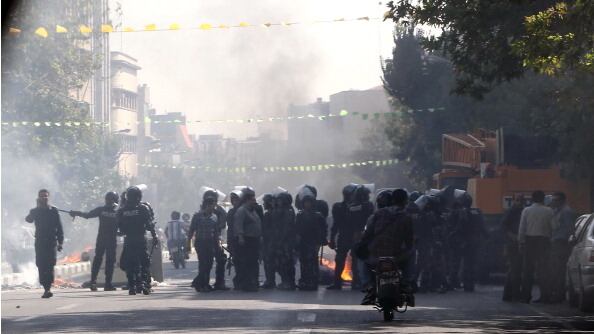Now is the autumn of Iranian discontent. And who can blame them? Over the past week, the value of Iran's Rial fell 40 percent against the dollar.
The economic woes drove Iranians into the streets of Tehran yesterday, where they reportedly clashed with riot police during a few modestly-sized and—best as I can tell—relatively isolated protests. The largest, and perhaps most significant, were in Iran's famed bazaar, which shut down as protesters moved through, and outside the Bank of Iran. At the former locale, the shopkeepers' closures ostensibly protected their stalls from demonstrators, but that doesn't seem to be how the story actually played out.

The latest protests seem unlikely to be the spark that brings down the Islamic Republic. Instead, they focused on the government's mismanagement of the economy—a realm, unlike foreign affairs and the nuclear program, where President Mahmoud Ahmadinejad actually has power to enact policies. But the showing could be a harbinger of what's to come as Iranians go to the polls next year.
Many analysts and media accounts speculated that the bazaaris had a hand in organizing the protests, a notion confirmed by a source in Tehran who normally keeps abreast of opposition goings-on by social media. The source found out about the protests late, remarking: "This time it's the bazaar, no need for Facebook or e-mail."
Iran's merchant class are the society's kingmakers, but their ire here doesn't seem to be directed solely at the rezhime, as they say in Farsi. Some protesters could reportedly be heard to shout "death for the dictator"—which could refer to Supreme Leader Ali Khamenei—but the slogan was directed against Iran's lame duck president, Ahmadinejad. According to the New York Times, some "bazaar traders hinted that the closing had been organized by powerful opponents of Mr. Ahmadinejad, who were trying to make him look weak."
Though Ahmadinejad is on his way out, he represents a strain of lay religious radicalism that the Green opposition and mainstream conservative clerical political factions have both been harshly critical of.
The quick response by riot police does not bode well for the political environment leading up to next year's presidential election in Iran, the first since Ahmadinejad's reelection—widely held to be a fraud—and the subsequent emergence of the Green Movement and harsh government crackdown. "Although it’s not clear if there will be more protests, one thing is certain: Iran will experience a much more securitized environment in the run up to the 2013 presidential elections," said Ali Vaez, a senior Iran analyst with the International Crisis Group.
The 2009 protest movement—the largest in Iran since 1979's Islamic Revolution—also initially started as an objection to the alleged vote fraud that placed Ahmadinejad back in power. But as frustration with the crackdown against protesters mounted, anti-regime sentiment became more prevalent, in some cases dividing the opposition between those who wanted to bring down the Islamic Republic and those who sought to reform it by electing the Islamic left.
The dynamic could play out the same way with protests against Iran's mismanagement of the economy. "There is a systematic failure on the part of the Islamic Republic to stem the economic crisis," said RAND Corporation Iran analyst Alireza Nader. "It's not just about sanctions, it's about the incompetence and dysfunction of the system, and not just Ahmadinejad." Iranians surely know this better than anyone. But will they take on the entire system?




